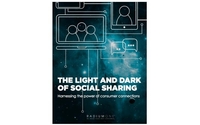Study Sheds New Light On 'Dark' Social, Finds Consumers Underestimate Their Own Behavior 2-to-1
- by Joe Mandese @mp_joemandese, December 1, 2014
 Nearly a third (32%) of consumers who share content with other
people digitally say they do it via so-called “dark social” channels such as email, SMS or other peer-to-peer platforms that are not as easy to see and monitor as so-called “light
social” networks such as Facebook, Twitter, Instagram and Pinterest.
Nearly a third (32%) of consumers who share content with other
people digitally say they do it via so-called “dark social” channels such as email, SMS or other peer-to-peer platforms that are not as easy to see and monitor as so-called “light
social” networks such as Facebook, Twitter, Instagram and Pinterest.
The self-reported findings, which come from a survey of more than 9,000 consumers in October by Tpoll, are interesting because they indicate that consumers are greatly underestimating their actual use of dark social channels when compared with actual behavioral tracking of content sharing.
According to RadiumOne, which released the Tpoll findings this morning as part of a new report, “The Light and Dark of Social Sharing,” found that actual content sharing is more like 69% “dark,” based on trends from its PO.ST content-sharing widgets.
That finding is much closer to the patterns found by 33Across’s Tynt database, which tracks actual copy-and-pasting of digital content across all channels and has consistently found that more than 70% of content-sharing is via dark social channels.
“Sharing activity through email, instant messaging and forum posts, aka dark social, is three times larger than the sharing activity on Facebook, globally,” the RadiumOne report finds, adding that “69% of all sharing activity takes place via dark social globally versus 23% via Facebook.”
RadiumOne also found that dark social represents the “majority” of sharing in 19 content categories, including “many that are important to advertisers such as travel, personal finance, technology and automotive.”
The report also found that more than a third of all social-sharing is now done via mobile device.
The report sheds another important ray of light on dark social sharing, finding that a third of consumers surveyed believe they only share via dark social. That percentage skews higher among older respondents.
While RadiumOne did not show corresponding behavior data on what percentage of consumers actually share exclusively via dark social, previous analysis from Tynt showed that people tend to share different types of information through light and dark social channels.
The Tynt data found that consumers generally share politically correct or socially acceptable content in light social channels, but share important and potentially valuable content such as financial news information or hot stock tips via dark channels.

